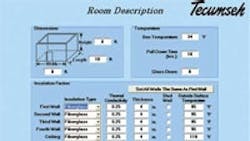Installation Tips: Communication a Key
By Jeff Fordeck
The process of selling a refrigeration system for a commercial refrigeration application is unique. Typically, the process starts out with a simple set of blueprints or a phone call to exchange some basic information.
At first, this information is generic, and usually contains a rough dimension for the box, maybe a specification for the material the box will be insulated with (polystyrene, cork, polyurethane foam, etc.), and in some rare instances a product load calculation.
From this information, a trained salesperson will make some assumptions about the product load, the insulation, the solar loading and the usage of the box, then comes up with a capacity calculation for the refrigeration system and makes the equipment selection. In many cases, these general assumptions are called out in the final quotation and the final selections that are suitable for the application are worked out.
It’s the applications that don’t fit into this category that require the keen eye of the installer. The installation crew needs to ensure that the final installation meets the needs of the customer and doesn’t cost more in call backs than the original job was worth.
For purposes of this article, let’s assume that the box was for a new neighborhood supermarket’s meat cooler. This assumption would have allowed the salesperson to select equipment that would operate at 38F and would allow some cost savings to be made in the selection of the coil. Beef is a fairly robust product, and since it’s typically wrapped, dehydration is not a major consideration in this assumption. Therefore, a smaller evaporator is selected, which gives a final temperature differential in the box of 12F.
Installation day arrives. Unfortunately, the refrigerated space will actually house fresh flowers, and will operate at a temperature of 42F. Normally, this would not be an issue. However, since a coil was selected with a 12F temperature differential, the flowers will dry out abnormally fast due to the humidity removal of the evaporator coil, and the product will not last the prescribed amount of time required by the owner.
Customer satisfaction is the responsibility of everyone involved in the process, and ultimately falls to the installer. With the rising cost of everything nowadays, everyone needs to strive in the pursuit of customer satisfaction. Fortunately, several tools are becoming available to assist in the proper installation of a system. Software tools to aid in the selection of equipment help to reduce errors and standardize some of the assumptions.
Equipment manufacturers are adding more content to their websites, and national training certifications help raise the education levels of the technicians. All of these, along with experience, combine to provide the customer with an installed product that will be solid and reliable for years to come.
Jeff Fordeck is director of product development and support for Tecumseh Products Company, Tecumseh, MI. He can be reached by calling 517/423-8570. Visit www.tecumseh.com for additional information.
